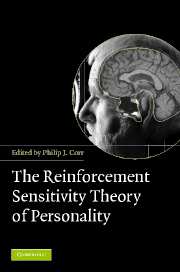Book contents
- Frontmatter
- Contents
- List of abbreviations
- List of figures
- List of tables
- List of contributors
- Preface
- 1 Reinforcement Sensitivity Theory (RST): introduction
- 2 The neuropsychology of fear and anxiety: a foundation for Reinforcement Sensitivity Theory
- 3 Animal cognition and human personality
- 4 The behavioural activation system: challenges and opportunities
- 5 Reinforcement Sensitivity Theory and personality
- 6 Reinforcement sensitivity scales
- 7 Performance and conditioning studies
- 8 Psychophysiological studies
- 9 Reinforcement Sensitivity Theory and mood induction studies
- 10 Neuro-imaging and genetics
- 11 Reinforcement Sensitivity Theory and psychosomatic medicine
- 12 RST and clinical disorders: anxiety and depression
- 13 RST and psychopathy: associations between psychopathy and the behavioral activation and inhibition systems
- 14 Behavioural activation and inhibition in social adjustment
- 15 Reinforcement sensitivity in the workplace: BIS/BAS in business
- 16 Formal and computational models of Reinforcement Sensitivity Theory
- 17 Reinforcement Sensitivity Theory: a critique from cognitive science
- 18 The contribution of Reinforcement Sensitivity Theory to personality theory
- General Index
- Index of Names
- References
4 - The behavioural activation system: challenges and opportunities
Published online by Cambridge University Press: 31 January 2011
- Frontmatter
- Contents
- List of abbreviations
- List of figures
- List of tables
- List of contributors
- Preface
- 1 Reinforcement Sensitivity Theory (RST): introduction
- 2 The neuropsychology of fear and anxiety: a foundation for Reinforcement Sensitivity Theory
- 3 Animal cognition and human personality
- 4 The behavioural activation system: challenges and opportunities
- 5 Reinforcement Sensitivity Theory and personality
- 6 Reinforcement sensitivity scales
- 7 Performance and conditioning studies
- 8 Psychophysiological studies
- 9 Reinforcement Sensitivity Theory and mood induction studies
- 10 Neuro-imaging and genetics
- 11 Reinforcement Sensitivity Theory and psychosomatic medicine
- 12 RST and clinical disorders: anxiety and depression
- 13 RST and psychopathy: associations between psychopathy and the behavioral activation and inhibition systems
- 14 Behavioural activation and inhibition in social adjustment
- 15 Reinforcement sensitivity in the workplace: BIS/BAS in business
- 16 Formal and computational models of Reinforcement Sensitivity Theory
- 17 Reinforcement Sensitivity Theory: a critique from cognitive science
- 18 The contribution of Reinforcement Sensitivity Theory to personality theory
- General Index
- Index of Names
- References
Summary
The influence of Reinforcement Sensitivity Theory (RST) on personality psychology has been far greater than Jeffrey Gray would ever have conceived. This is especially the case for the Behavioural Activation System (or Behavioural Approach System) (BAS), which was introduced to his model on a somewhat arbitrary basis, only to be embraced by others as a major organizing framework for trait explanation. In the last few years, RST has been substantially revised in a number of aspects (as discussed in other chapters of this book), particularly centring on the role of the Behavioural Inhibition System (BIS) and Fight-Flight-Freeze System (FFFS). This might give the impression that the changes in thinking about the BAS have been relatively minor. We would argue that this impression is misleading and that an equally radical review of the BAS is called for (as we have been arguing in a series of articles: Pickering and Gray 1999, 2001; Pickering 2004; Smillie, Pickering and Jackson 2006). In this chapter we highlight the opportunities ahead at this time of theoretical flux, sketch some of the challenges to be met by future research, and suggest what we believe may be some promising initial steps in this process.
A time for rethinking the BAS within RST
Like Gray's other brain-behavioural systems, such as the BIS, the BAS was originally defined in ethological terms (see Gray 1987c).
- Type
- Chapter
- Information
- The Reinforcement Sensitivity Theory of Personality , pp. 120 - 154Publisher: Cambridge University PressPrint publication year: 2008
References
- 17
- Cited by



